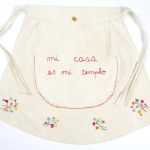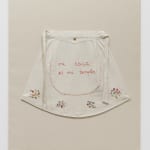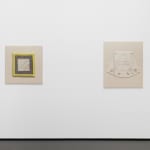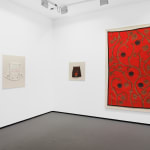Feliciano Centurión
Mi casa es mi templo [My house is my temple], 1996
Embroidery with inclusion on fabric
53 x 63 cms
20 7/8 x 24 3/4 inches
20 7/8 x 24 3/4 inches
Further images
‘Mi casa es mi templo’ is a readymade, white apron with four bunches of colourful, embroidered flowers decorating the bottom. In the centre of the apron we see the titular...
‘Mi casa es mi templo’ is a readymade, white apron with four bunches of colourful, embroidered flowers decorating the bottom. In the centre of the apron we see the titular phrase embroidered in red, cursive, lower-case letters.
Feliciano Centurión understood the history of the gendered associations of textile production and he chose to embrace the domestic connotations of the practice. This work directly interacts with these assumptions surrounding domesticity and femininity. The textile works made by Centurión towards the end of his life reveal a nexus at which an affront to conservative art histories and gender-normative behaviours mingles with a practice that is also assumed for its therapeutic effect, practical convenience and tactile potential.
The phrase at the heart of this work has religious connotations, it elevates and consecrates the domestic sphere. The home represented, for the artist, a sanctuary - a place of safety and rest. Furthermore, for Centurión, the notion of finding comfort at home relates to his illness with AIDS and his identity as a Paraguayan immigrant living in Argentina; it relates to the inevitable search for physical belonging and refuge.
Feliciano Centurión understood the history of the gendered associations of textile production and he chose to embrace the domestic connotations of the practice. This work directly interacts with these assumptions surrounding domesticity and femininity. The textile works made by Centurión towards the end of his life reveal a nexus at which an affront to conservative art histories and gender-normative behaviours mingles with a practice that is also assumed for its therapeutic effect, practical convenience and tactile potential.
The phrase at the heart of this work has religious connotations, it elevates and consecrates the domestic sphere. The home represented, for the artist, a sanctuary - a place of safety and rest. Furthermore, for Centurión, the notion of finding comfort at home relates to his illness with AIDS and his identity as a Paraguayan immigrant living in Argentina; it relates to the inevitable search for physical belonging and refuge.
Provenance
Artist's Family EstateExhibitions
Feliciano Centurión: Abrigo at the Americas Society, New York (February 14–May 16, 2020)Affective Affinities - 33rd Biennial of São Paulo, Brazil (7th September - 9th December, 2018)
Publications
Iglesias Lukin, Aimé, and Karen Marta. Eds. Feliciano Centurión: Abrigo. p. 88, illustrated. New York: Americas Society, 2020Iglesias Lukin, Aimé, and Karen Marta. Eds. Feliciano Centurión. p. 128-29, illustrated. New York: Americas Society, 2020
Pérez-Barreiro, Gabriel, and Fabiana Werneck, eds., 33rd Bienal de São Paulo: Affective Affinities: Livro Registro, 162–63, illustrated. São Paulo: Fundação Bienal de São Paulo, 2018.
Join our mailing list
* denotes required fields
We use cookies on our website to improve your experience. You can find out why by reading our Privacy Policy.
By continuing to browse our site you agree to our use of cookies.
![Feliciano Centurión, Mi casa es mi templo [My house is my temple], 1996](https://artlogic-res.cloudinary.com/w_1600,h_1600,c_limit,f_auto,fl_lossy,q_auto/artlogicstorage/cbprojects/images/view/4a2b401d9d84767c2f59569aaab6035fj.jpg)
![Feliciano Centurión, Mi casa es mi templo [My house is my temple], 1996](https://artlogic-res.cloudinary.com/w_1600,h_1600,c_limit,f_auto,fl_lossy,q_auto/artlogicstorage/cbprojects/images/view/7adb17d4d4a5913877ec4d4bb00b6a80j.jpg)
![Feliciano Centurión, Mi casa es mi templo [My house is my temple], 1996](https://artlogic-res.cloudinary.com/w_1600,h_1600,c_limit,f_auto,fl_lossy,q_auto/artlogicstorage/cbprojects/images/view/c48e6f8865b2863593f3895f6d979bfdj.jpg)
![Feliciano Centurión, Mi casa es mi templo [My house is my temple], 1996](https://artlogic-res.cloudinary.com/w_1600,h_1600,c_limit,f_auto,fl_lossy,q_auto/artlogicstorage/cbprojects/images/view/bc37596fc08b1fb4d6951d34c5544c44j.jpg)



